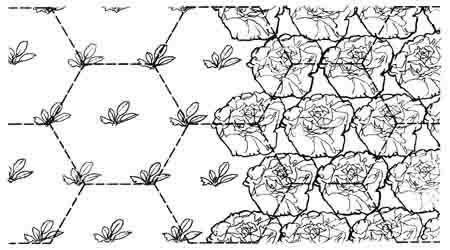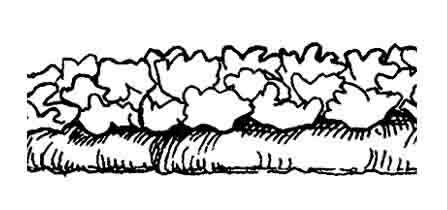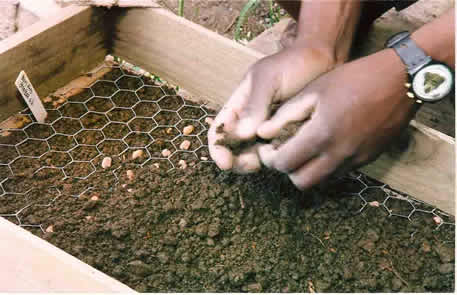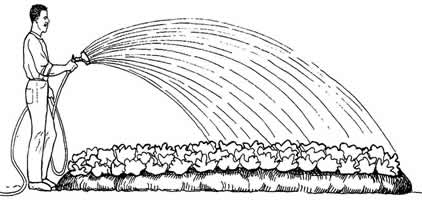Principle 3:
Intensive Planting
Goal: Create enhanced and
uninterrupted root and plant growth
The third leg of the stool is intensive planting. It creates enhanced and uninterrupted plant and root growth by transplanting seedlings in a close, off-set spacing pattern so their leaves are barely touching at maturity, creating a living mulch over the soil!
The living mulch results in a mini-climate between the plants and the soil, retaining moisture and protecting soil from wind and water exposure that can lead to erosion. Intensive planting also maximizes root material, which increases the biological activity and the organic matter in the soil. (When the soil is healthy, roots can be healthy; when roots are healthy, plants can be healthy.)
Intensive planting limits weed growth, supporting the plants and saving labor. Additionally, the farmer benefits because the hexagonal pattern maximizes the number of plants in a given area, increasing yield.
From above, the pattern looks like this:
Roll over the picture with your mouse to view second image
Images 1: A spacing grid showing mature and immature plants;
2: The end result of close spacing is a comfortably full bed that provides its
own 'living mulch'.Each plant is the same distance from all the plants around it. In the center is the seedling and the circle around it is the area the plant covers when it is full-grown. From the side, the leaves should look like this:
Roll over the picture with your mouse to view second image
Images: Profile views of close-spaced vegetable plants..
GB Farmer’s Challenge:
Experiment with the best spacing for your climate. For example, try lettuce 8, 10, 12, and 14 in (20, 25, 30, 35 cm) apart and measure your yields per unit of area to compare production, soil coverage, and plant health. Remember to try experiments 3 or more times to be confident in the conclusions!
Intensive planting is also utilized in the process of growing your own seedlings for transplanting. This farming practice contributes to the sustainability of the farm through supporting a closed system (not buying seedlings). Seedlings can be grown in flats, in any container that drains well and is deep enough for roots (at least 3 in/ 7.5 cm), or in a nursery bed. Propagate seedlings in a way that allows them enough room to grow, while creating a good mini-climate over the flat, container or bed. Use the off-set spacing pattern, putting most seeds on 1 or 2 in (2.5 or 5 cm) spacing. If the seeds are too small to handle, scatter them evenly. To have enough space for the seedlings to develop properly, it may be necessary to move these seedlings to another flat, container or area on off-set spacing once they have germinated. This process is called “pricking out.” Most seedlings are pricked out on 1.5 or 2 in (3 or 5 cm) spacing.
Roll over the picture with your mouse to view second image
Images 1: A planting grid can help with intensive sowing of seeds;
2: Close-spaced seedlings in a seedling flat.Your plants will be healthiest if you transplant the seedlings when their roots and leaves are thriving and in balance with one another. Roots are too big when they’ve hit the bottom of the flat or container. Remember to harden off seedlings for a few days before transplanting by bringing them from a protected temperature into the ambient temperature. Transplanting is best done in the cool of the day, followed by immediate watering to settle the roots into the soil.
Hint:
To attend to the closed system of the farm, make flat soil (soil used in flats or containers for seedling propagation) from equal amounts of compost and bed soil (from the double-dig). Once soil is available from used flats or containers, use equal parts of old flat soil, compost, and bed soil. If seedlings were diseased, use that old flat soil for compost where the microorganisms can transform it.
Transplanting is preferable to directly sowing seeds in the bed because you can:
- avoid empty spaces in the bed caused by poor seed germination,
- establish living mulch faster because seedlings are already large;
therefore they cover the soil sooner and the soil requires less water,
- use the healthiest seedlings to maximize yield,
- produce warm-loving seedlings earlier (with some protection)
that will be ready to plant when the weather allows, and
- bring the crop already in the bed to fuller maturity (producing
more compost material and higher yields), while the seedlings
are growing.
Hint:
Some fast growing plants like radishes don’t benefit from transplanting.
Another important part of attaining enhanced and uninterrupted plant and root growth is watering gently. If the rains aren’t enough and you water your garden, make the water fall gently like raindrops instead of beating onto the plants or running over the soil. And remember if the soil is healthy, the plants will benefit, so when watering think about creating good soil moisture instead of focusing on the plants .
Image Water so that the drops fall like rain on your plants and soil.
Hint:
If the plants look stressed, check the soil 2, 6, and 8 in (5, 10, 15 cm) deep, there may be a hidden moisture imbalance.
Using intensive planting, along with compost and deep soil preparation, is the foundation for a sustainable farm. These principles work together to create and support a healthy, vibrant soil, which can produce higher yields. A key in sustainable farming is to recognize that soil is the foundation of life! Farmers grow food that nurtures life; therefore, farmers must grow and honor the soil.
These first three principles of GROW BIOINTENSIVE take care of the soil; they are the three legs that are the solid foundation of a good stool. To strengthen the system and complete the stool, the GB farmer employs five more principles.
GB Farmer’s Challenge:
Continue reading and implement these ideas on your farm. Watch carefully to see the patterns that are consistent between beds, crops, and seasons. Learn from these patterns and remember that things take time.



